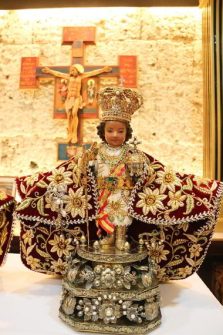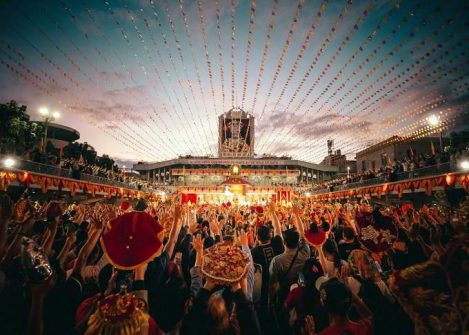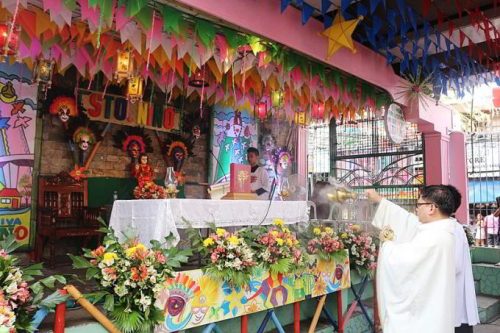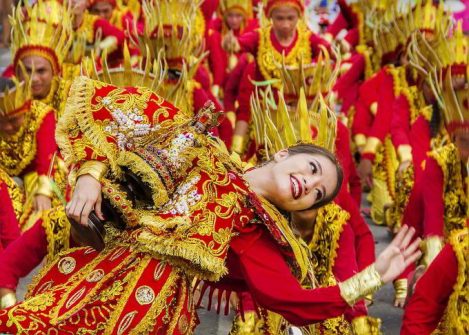The Philippines. Santo Niño Devotion. The Filipino Faith.

The image of the Santo Niño is a symbol of Filipino devotion, rooted in the traditions and history of Catholicism in the Philippines. This year, it will be celebrated on 19 January.
The origin of the Santo Niño devotion dates back to 1565, 44 years after the Christian faith was brought to the Philippine archipelago to celebrate the first mass and the first mass baptism. The image of the Child Jesus now in the Minor Basilica del Santo Nino in Cebu is the same image that Ferdinand Magellan gave to Hara Humamay, wife of Rajah Humabon, during the first baptism celebration in 1521.Three constitutive elements are associated with this devotion and its origin: the image itself, the minor basilica, and the popular religiosity related to Santo Niño.
The Image – In February 1565, Miguel López de Legaspi and the Spanish contingent, with Fray Andrés de Urdaneta, OSA (1498-1568) and his pioneering missionary companions, arrived on the island of Sugbu. There, this priceless icon of the Santo Niño was discovered (Kaplag) among the burnt ruins by the Spanish soldier Juan de Camus, who gave it to Legaspi. The Kaplag of the image caused a kind of holy excitement among them, an inspiration to build a camp and a temporary chapel where it was found, and a motivation to begin their mission
of evangelisation.

The original image of Santo Niño de Cebú, is enshrined at the Basilica Minore del Santo Niño.CC BY-SA 4.0/Cofradiabsn
Legazpi entrusted the image to the Augustinian missionaries, who, under Father Andres de Urdaneta’s lead, enthroned the Santo Niño’s image in the chapel with great ceremony. Attracted by these Christian rites, the indigenous people of the islands came out of hiding to watch from a distance.
The Christian rites in which the image of the Santo Niño was found were the first crack in the hostile relationship between the Spaniards and the natives.
The discovery of the image marked the beginning of the formal Christianisation of the Philippines and was an important point in the history of the Philippine Church. The holy icon of the Holy Child, now enthroned in the Minor Basilica del Santo Niño in Cebu, is considered the oldest Christian relic in the country and is believed by most Filipinos to be miraculous.
This icon was canonically crowned on 28 April 1965 by the Papal Bull “Cunabula Religionis” issued by Pope Paul VI on 27 February 1964. This makes the Santo Niño the only image of Jesus Christ in the Philippines to have received such official recognition through a decree of canonical crowning by the Holy See. This official recognition was granted after Julio Cardinal Rosales, then Archbishop of Cebu, and Fr. Luciano Rubio, OSA, former Prior General of the Augustinians, made a special request in a joint letter entitled “The Philippines for Christ”.
The Minor Basilica – News of the arrival of the Spanish conquistadors and missionaries reached the ears of the local king, Rajah Tupas, who was informed of Legaspi’s intention to talk peace with him. The monarch accepted the commander’s invitation and presented himself at the Spanish camp on 8 May 1565. That day fell on the Feast of the Apparition of the Archangel Michael, and so Legazpi named the place “Villa de San Miguel”. Eventually, both leaders signed a peace treaty known in history as the Treaty of Cebu.

Novena Mass at Basilica del Santo Niño.CC BY-SA 4.0/Jumelito Capilot
In May 1565, Legaspi also planned the urbanisation of the island and allocated a place for the church and convent of San Agustin, “where the image of the Santo Niño was found”. In his honour, the Spanish missionaries established the Brotherhood of the Holy Child, La Cofradia del Santo Niño de Cebu, and made Legaspi its first Hermano Mayor.
The original chapel, built of wood and nipa by Fray Diego de Herrera, OSA, was the first house of worship ever built in the country. But it was destroyed by fire. In 1605 the Augustinian missionaries built a new church, again of light materials, which was burnt down in 1628.
In 1735, the Augustinian Provincial, together with the Spanish Governor General and Bishop Manuel Antonio Decio y Ocampo of Cebu, laid a more solid foundation for a larger and more concrete church, which was completed in 1740. Like the legendary phoenix rising from the ashes with renewed vigour, this sanctuary became today’s Basilica Minore del Santo Niño de Cebu and has become a favourite destination for millions of pilgrims every year.
Pope Paul VI raised the status of the historic church to that of a Minor Basilica on 2 May 1965 through Cardinal Hildebrando Antoniutti, the papal legate to the Philippines, who had come to celebrate the centenary of the country’s Christianisation. In a papal bull, the Holy Father recognised the temple as “a symbol of the birth and growth of Christianity… the Mother and Head of all the Churches in the Philippines” (Mater et Caput… omnium ecclesiarum insularum Philippinarum).
Popular Religiosity and Devotion – The Augustinian missionaries immediately spread the devotion to the Holy Child to other places, which led to the construction of other temples dedicated to the Child Jesus. In Manila, there are historic churches dedicated to Santo Niño de Tondo and Santo Niño de Pandacan; in Leyte, there is a church dedicated to Santo Niño de Tacloban.

Celebration of the Santo Nino in Manila. CC BY-SA 2.0/Glendale Lapastora
Every year, Catholics from Negros and Iloilo visit the church in Tigbauan to pay homage to the Santo Niño. A small basilica in Batangas City is also dedicated to the Santo Niño de Batangan, and a hundred other shrines and chapels have been built and consecrated in honour of the Holy Child throughout the archipelago.
Today, the image of Santo Niño de Cebu is one of the most beloved and recognizable cultural icons in the Philippines. It can be found in both religious and secular places, replicated in many Filipino homes, jeepneys, buses, business establishments, malls, government offices, barangay halls, and schools.
Outside the Philippines, Santo Niño de Cebu is the only Filipino identity registered in the National Registry of Cultural and Historical Places in Washington D.C., USA. This recognition is due to the religious devotion of Filipino devotees who brought replicas of the image of the Santo Niño de Cebu to the United States and Canada.

Street Dancing.CC BY-SA 4.0/Mark Linel Padecio
In the Middle East, Filipino communities have celebrated the feast of the Holy Child in Dubai and Kuwait over the years, showcasing to the Arab world the colourful and joyous devotion to the Santo Niño. Filipinos have indeed spread this special devotion far and wide.
After five hundred years, devotees still experience the deep impact of Kaplag as millions join and enjoy the Sinulog-Santo Niño festivities held on the third Sunday of January in Cebu, as well as the Dinagyang of Iloilo. Both are said to be adaptations of Kalibo’s Ati-Atihan Festival.
In keeping with the celebration’s origins, participants in the main parade paint their faces with black soot and wear highly decorative colourful costumes, dancing two steps forward and one step back as they sway to a distinctive drum rhythm. A week-long Mardi Gras-like festival in honour of Santo Niño consumes many of the archipelago’s towns and villages yearly. (Photo: Part of the activities of the Sinulog festival is the street dance in honour of the Santo Niño. CC BY-SA 4.0/Jumelito Capilot)
Jose Maximiano



